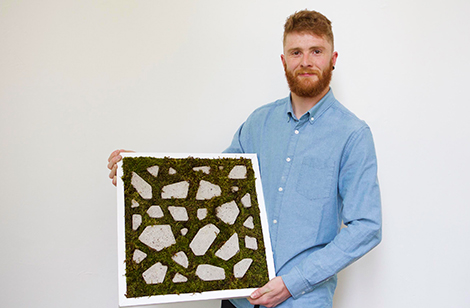
Tackling air pollution filtering into the workplace, Jack Johnson has designed a low-maintenance natural moss wall tile to absorb toxins
As cities become more congested, and more people start to take notice of the horrifying effects inhaling toxins can have, a UK student has designed a wall panel for building interiors to combat air pollution.
Jack Johnson, a Product Design student graduating from Nottingham Trent University this summer, has designed a lightweight, inexpensive and durable ‘Foamcrete’ tile, that allows moss to grow.
Johnson suggests that the moss chosen can remove gases such as carbon dioxide, sulphur dioxide and nitrogen dioxide from the air, a space saving and effective alternative to using plants in offices.
Inspired by a Chinese room divider, panels need just a light misting with water to survive, and each 450 x 450mm panel neutralises 4.92m³ of polluted air.
“I was particularly inspired by the smog that affects Beijing, which was especially bad at the start of the year,” said Johnson.
“High levels of gases in the air are related to the cause of various respiratory afflictions such as bronchitis and can increase the likelihood of developing cancer. Whilst traditional air purifiers remove elements such as dirt and pollen and regulate air temperature, many fail to remove the tiny gaseous particles that remain and still pose a health risk.
“Moss is a natural and inexpensive method of neutralising air pollution and, as the panels do not take up valuable office floor space, they are more suitable than plants to perform this function. They only need a minimum amount of soil and water to thrive and are aesthetically pleasing too.”






